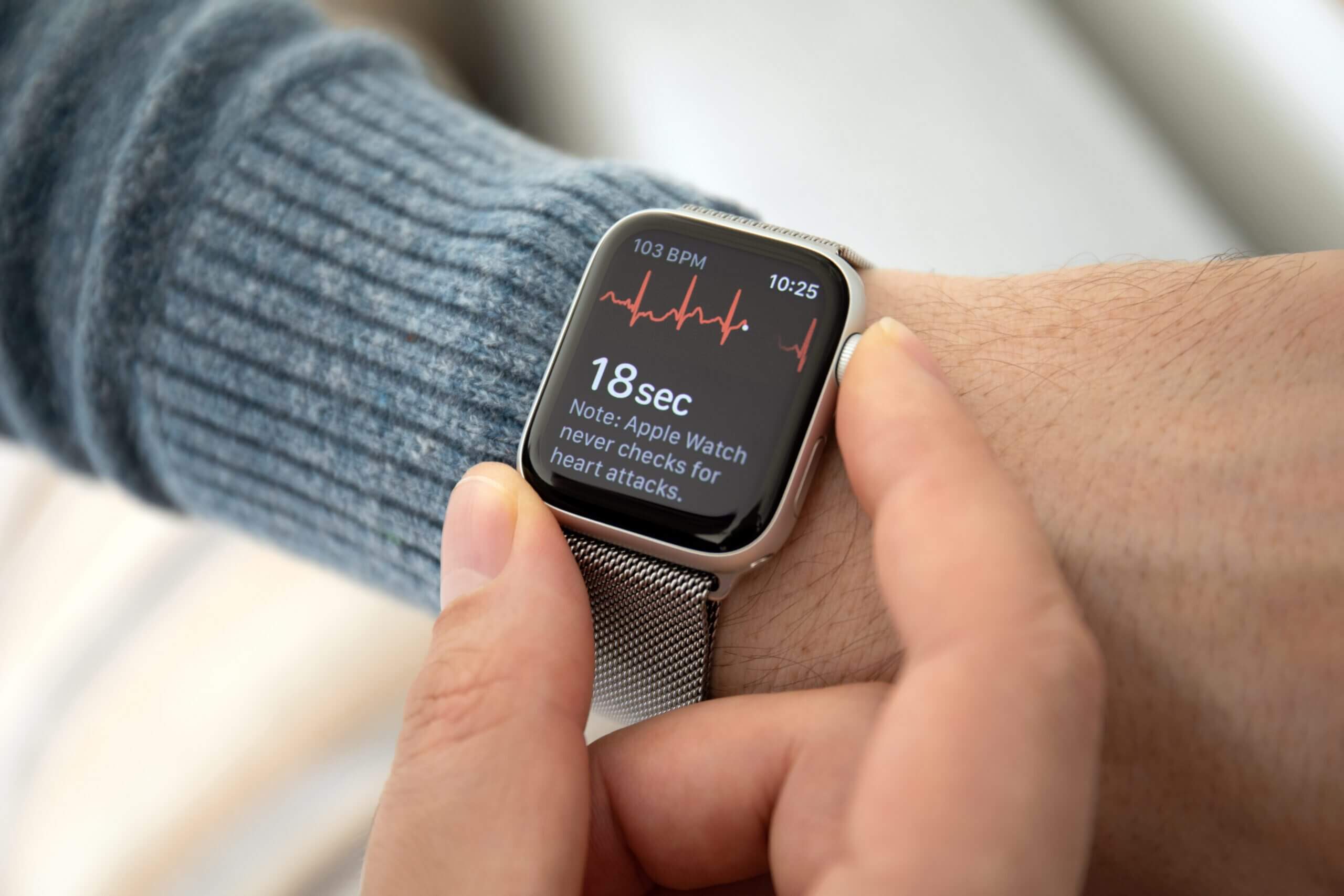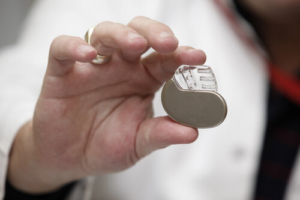Learn more about smart watches that detect AFib. Did you know that you can track your AFib symptoms outside the doctor’s office?
As the most common heart arrhythmia experienced across the country, an estimated 5 million Americans are affected by atrial fibrillation. With the number of people living with AFib rising year after year, innovation with at-home monitoring has become an essential component of successful care — and wearable health devices have become the popular solution.
Looking to explore the benefits of wearable cardiac tracking devices, this article explores various at-home tools you can use to track your heart health — including detecting irregularities, monitoring your heart rate and rhythm during exercise and rest, and creating accurate ECG reports during an AFib attack.
If you or someone you love has been struggling to manage the symptoms of AFib, this article is for you. Let’s get right into it!
What is Wearable Health Technology?
Wearable health technology includes all at-home monitoring devices worn on the body. They are most commonly worn on the wrist for ease of use.
Capable of monitoring and recording data on a wide variety of health measurements, different wearable devices can track different vital signs, including:
-
Changes in heart rate and rhythm
-
Blood pressure
-
Oxygen saturation levels
-
Sleep patterns and quality
-
The number of steps you take per day
-
The amount of physical activity you get daily
-
And more!
Because of their diverse capabilities, not all wearable health devices are helpful for patients with AFib. For the best results, devices that specifically track cardiac health changes, including recording a real time ecg, are often the most beneficial for people with atrial fibrillation.
The benefits of wearable technology for AFib management
At-home wearable technology is a helpful resource for all patients living with atrial fibrillation. Depending on your unique situation and the device you choose to wear, this technology can offer numerous benefits, including:
-
Real-time heart monitoring — Episodes of AFib often come and go, seemingly out of nowhere. If you are wearing an at-home health device, you are more likely to be able to track (and record) evidence of an AFib attack, no matter when and where it strikes.
-
Early detection of irregular heartbeat — Before you begin to feel symptoms of an AFib attack, your heart may already be in an irregular heart rate pattern. Tackle your symptoms sooner and potentially catch an episode of AFib symptoms before it starts by wearing an at-home health device. Some watches even have an alert system that can notify you of atrial fibrillation before you feel any symptoms.
-
Personalized insights into daily activities and exercise — As a device that tracks and records your health every single day, your wearable health technology can help to provide helpful insights into your daily activities and overall wellness. Looking at these trends can help to personalize your treatment and improve your AFib symptoms in a more natural and lifestyle-based way.
-
Data sharing capabilities with your primary care provider — After recording an episode of AFib symptoms, many wearable health devices can send the recorded data directly to your primary healthcare provider. Because of this, your care provider will get a better understanding of the severity and frequency of your symptoms, allowing them to make more personalized health recommendations to improve your care.
Smart Watches that Detect AFib: Dr. AFib’s Top Wearable Devices for Patients with AFib
As an electrophysiologist with over a decade of experience providing care for patients with AFib, I have come across plenty of wearable health devices advertised to help with at-home monitoring of atrial fibrillation. Here are a few of my favorites that I recommend my patients to try:
The Apple Watch
As one of the most well-known wearable health devices on the market today, the Apple Watch (from series 4 onward) is capable of monitoring, tracking, and creating accurate heart rate and rhythm records.
Worn on the wrist and made with a built-in heart rate sensor and ECG, the recent series of the Apple Watch can detect and alert the wearer of irregular heart rhythms consistent with an AFib attack.
Easy to use and compatible with all other Apple devices, the Apple Watch also offers data-sharing options to provide your primary care provider insights into your daily health and symptoms. Depending on the make and model you choose, the Apple Watch starts at $249.
Apple Watch features:
-
Heart rate monitor — When wearing the device, the Apple Watch records your heart rate. Over time, the Apple Watch will create trends based on your resting heart rate and average heart rate during exercise and can identify irregular heart rates and rhythms.
-
ECG app — The Apple Watch can record ECGs at any time, perfect for collecting data if you have sudden-onset AFib symptoms. To record an ECG, sit still for 30 seconds with your finger on the crown of the watch with the ECG app open. The Apple Watch will record an accurate ECG, which can be shared with your primary care provider.
-
Notifications and alerts — If you experience a heart rate or rhythm that is low, high, or irregular, your Apple Watch will send you a notification. This is a helpful resource for catching AFib attacks early, giving you the best chance to treat and possibly prevent the development of symptoms.
-
General fitness tracking — The Apple Watch can also record information about other health metrics, including sleep quality, exercise and fitness tracking, women’s health cycle monitoring, and more.
Read my other blog on the Apple Watch and AFib monitoring here.
The Fitbit Sense Watch
As another popular fitness watch monitoring brand, Fitbit is known for exercise and health monitoring. The Fitbit Sense is a versatile smartwatch with advanced heart health features, such as ECG monitoring and heart rate variability tracking. The device can notify users of unusual heart rate patterns and help them make informed decisions about their health. The Fitbit Sense starts at $159.99, but other models can cost more.
Fitbit Sense features:
-
ECG app — Use the Fitbit ECG app for easy, on-demand atrial fibrillation monitoring, no matter where you are. All ECGs can be shared with healthcare providers for additional treatment insights.
-
Heart rate tracking — The Fitbit Sense offers regular heart rate tracking and mapping, which can provide helpful insights into AFib symptoms, sleep quality, stress levels, and activity.
-
Notifications — Receive notifications to your Android or Apple smartphone if you experience low, high, or irregular heart rates at any time when wearing the Fitbit Sense.
The Samsung Galaxy Watch
The Samsung Galaxy Watch is a popular choice for people who use Samsung Android smartphones. Capable of monitoring your sleep patterns, heart rate, and overall fitness and wellness tracking, this wearable device boasts a powerful battery for long-term wear throughout the day. The Samsung Galaxy Watch starts at $253.99 for the latest model, with other more advanced options available for an additional cost.
Samsung Galaxy Watch features:
-
Heart rate monitor — Made with an optical heart rate sensor, the Samsung Galaxy Watch can monitor changes in your resting and active heart rate and blood pressure.
-
ECG capabilities — The Samsung Galaxy Watch can create a real-time ECG map, no matter where you are. All ECGs created using this watch can be shared with your healthcare provider for additional analysis.
-
Waterproof design — Created to be waterproof and sweatproof, the Samsung Galaxy5 Watch is a great choice for anyone who likes to work out regularly.
Google Pixel Watch
As another popular Android option, the Google Pixel Watch combines the technology of Google products with the fitness-tracking capabilities of Fitbit products. Made to be used for both fitness monitoring and workplace productivity, this is a great choice for busy working professionals on the go. The Google Pixel Watch starts at $349 for the baseline model.
Google Pixel Watch features:
-
Fitbit heart rate tracking — Created to use Fitbit tracking technology, the Google Pixel Watch can monitor and notify its user of changes to their resting and active heart rates. Additionally, this watch will notify you if your heart rate becomes irregular, which can help to catch AFib episodes as early as possible.
-
ECG app monitoring — The Google Pixel Watch can monitor and record an accurate ECG reading in 30 seconds using the watch’s crown. This ECG can later be shared with healthcare professionals.
-
Sleek, round design — Made with a bold, circular design, the Google Pixel Watch is a sleek and stylish option for anyone looking to improve the look and feel of their wearable health technology.
Smart Watches that Detect AFib: Tips for Choosing the Ideal Wearable Device
Similar to treatment options for atrial fibrillation, choosing the right wearable health device is dependent on many different personal factors. In order to select the best possible device for your lifestyle, I advise considering the following factors:
-
Device accuracy — Before buying, read reviews for the accuracy of the device’s heart rate and ECG monitor accuracy. For patients with AFib, this is a super important metric for the device to get right to be an asset in your care and health.
-
Battery life and durability — How long can the device last without charging? For patients with busy lifestyles, long-lasting battery life, and durability will be required to get the most out of a wearable health device.
-
Ease of use — How simple is the device to use? Wearable devices with more features can be more complicated to use, which may not be the best first for patients looking to simply monitor their heart health.
-
Bonus features and functions — Sleep monitoring, exercise recording, and step counting are just a few additional metrics that can be measured by wearable devices. If these features interest you, be sure to select a device that is capable of tracking these metrics in addition to cardiac monitoring.
-
Price and warranty — New wearable devices can come with an expensive price point. Always consider the price and the length of its warranty before deciding which wearable health device to purchase.
Frequently Asked Questions About Smart Watches that Detect AFib
Apple Watch vs. KardiaMobile 6L — which is better for monitoring AFib?
The Apple Watch and KardiaMobile 6L are both popular choices for at-home AFib monitoring. For patients looking for a specialized, medical-grade ECG device that will create accurate ECG reports from home, I usually recommend the KardiaMobile 6L. In my opinion the Kardiamobile 6L is the most accurate at home monitor for AFib, and usually procedures high quality images for your doctor to review. For those looking for a more multi-functional health monitoring device capable of tracking cardiac activity in addition to fitness and sleep metrics, the Apple Watch can be a better choice.
Do I Need to Wear my Health Device Every Day?
For the best possible results, your wearable health device should be worn daily or as often as possible. The more often you wear it, the more data can be collected, which, over time, will create a more accurate picture of your health and symptom frequency.
Can I Monitor my AFib Symptoms at Home?
Yes, and it is encouraged! Using a symptom journal and wearable health technology, patients can monitor and track their AFib symptoms from home. The results of these efforts can be shared with your primary care provider to create more personalized treatment plans.
Are Wearable Health Devices Worth It?
Yes. If you or someone you love is interested in reducing the severity and frequency of AFib symptoms, recording data about your health is worth the investment. Capable of helping to identify possible triggers, recording early signs of irregular heart rhythms, and more, wearable health technology is quickly becoming a very helpful tool in the long-term successful management of atrial fibrillation.
Putting it All Together
As modern technology advances, we can expect to see even more sophisticated wearables designed for AFib management.
Future developments may include improved accuracy in detecting irregular heartbeats, AI-driven personalized health recommendations, seamless integration with other medical devices or telehealth services, and more — so why not start with at-home health monitoring today?
Wearable technology for atrial fibrillation monitoring has the potential to revolutionize how people with AFib manage their condition. By providing real-time insights into heart health, these devices empower users to take control of their well-being and work closely with their healthcare providers for optimal care.
If you’re living with AFib, I hope this article makes you consider exploring the latest wearable devices to help monitor and improve your heart health. These devices have been incredibly helpful for many of my patients, and I hope they are for you as well!
The Best Atrial Fibrillation Book
Your Complete Guide To AFib: The Essential Manual For Every Patient With Atrial Fibrillation
$15.95 (as of April 26, 2024 10:31 GMT -06:00 - More infoProduct prices and availability are accurate as of the date/time indicated and are subject to change. Any price and availability information displayed on [relevant Amazon Site(s), as applicable] at the time of purchase will apply to the purchase of this product.) The A to Z guide on everything you need to know about atrial fibrillation. Written by AFib expert Dr. Percy Morales MD. Over 120 pages of essential information on medications, procedures, and lifestyles modifications for AFib. Easy to read for every patient.
Shop AFib Products on Amazon
KardiaMobile 6-Lead Personal EKG Monitor – Six Views of The Heart – Detects AFib and Irregular Arrhythmias – Instant Results in 30 Seconds – Works with Most Smartphones - FSA/HSA Eligible

KardiaMobile 1-Lead Personal EKG Monitor – Record EKGs at Home – Detects AFib and Irregular Arrhythmias – Instant Results in 30 Seconds – Easy to Use – Works with Most Smartphones - FSA/HSA Eligible

Apple Watch Series 9 [GPS 41mm] Smartwatch with Storm Blue Aluminum Case with Silver Sport Band M/L. Fitness Tracker, Blood Oxygen & ECG Apps, Always-On Retina Display

Fitbit Sense 2 Advanced Health and Fitness Smartwatch with Tools to Manage Stress and Sleep, ECG App, SpO2, 24/7 Heart Rate and GPS, Shadow Grey/Graphite, One Size (S & L Bands Included)

OMRON - Complete Wireless Upper Arm Blood Pressure Monitor + EKG - Built-in Bluetooth Technology

Omron Hem 7361T Bluetooth Digital Blood Pressure Monitor with Afib Indicator and 360° Accuracy Intelliwrap Cuff for Most Accurate Measurements (White)

EMAY Portable ECG Monitor | Record ECG and Heart Rate Anytime Anywhere | Stand-Alone Device with LCD Screen and Storage | No Subscription Required

Samsung Galaxy Watch 6 44mm Smartwatch with HR Zones, Sleep Coaching, Heart Monitor - Graphite

Natural Rhythm Triple Calm Magnesium 150 mg - 120 Capsules – Magnesium Complex Compound Supplement with Magnesium Glycinate, Malate, and Taurate. Calming Blend for Promoting Rest and Relaxation.

Pure Encapsulations Magnesium (Glycinate) - Supplement to Support Stress Relief, Sleep, Heart Health, Nerves, Muscles, and Metabolism* - with Magnesium Glycinate - 180 Capsules


















![Apple Watch Series 9 [GPS 41mm] Smartwatch with Storm Blue Aluminum Case with Silver Sport Band M/L. Fitness Tracker, Blood Oxygen & ECG Apps, Always-On Retina Display #1](https://m.media-amazon.com/images/I/311xwtp4mFL._SL100_.jpg)
![Apple Watch Series 9 [GPS 41mm] Smartwatch with Storm Blue Aluminum Case with Silver Sport Band M/L. Fitness Tracker, Blood Oxygen & ECG Apps, Always-On Retina Display #2](https://m.media-amazon.com/images/I/41j+8AaUGsL._SL100_.jpg)
![Apple Watch Series 9 [GPS 41mm] Smartwatch with Storm Blue Aluminum Case with Silver Sport Band M/L. Fitness Tracker, Blood Oxygen & ECG Apps, Always-On Retina Display #3](https://m.media-amazon.com/images/I/41jIyxZitnL._SL100_.jpg)
![Apple Watch Series 9 [GPS 41mm] Smartwatch with Storm Blue Aluminum Case with Silver Sport Band M/L. Fitness Tracker, Blood Oxygen & ECG Apps, Always-On Retina Display #4](https://m.media-amazon.com/images/I/41IpNJERjCL._SL100_.jpg)
![Apple Watch Series 9 [GPS 41mm] Smartwatch with Storm Blue Aluminum Case with Silver Sport Band M/L. Fitness Tracker, Blood Oxygen & ECG Apps, Always-On Retina Display #5](https://m.media-amazon.com/images/I/31o17yhfYpL._SL100_.jpg)

















































